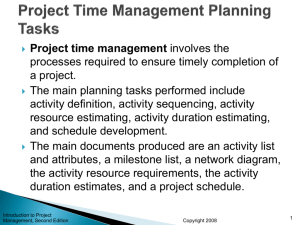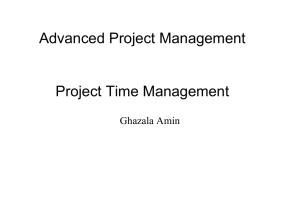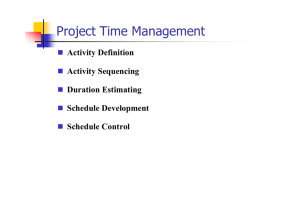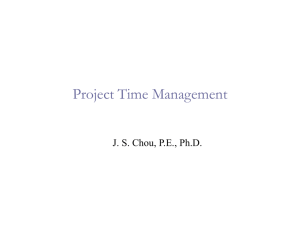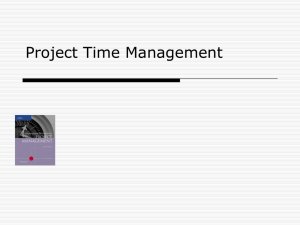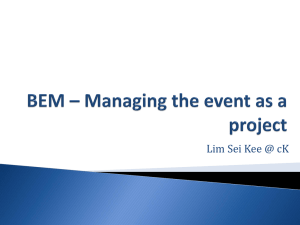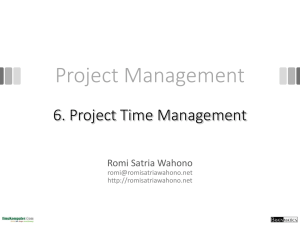08_Ch06
advertisement
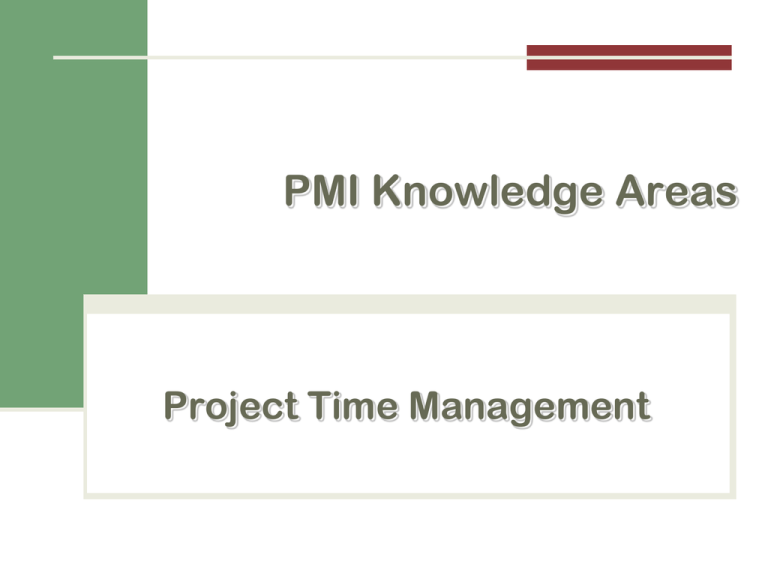
PMI Knowledge Areas Project Time Management Announcements Project Deliverables Project – Integration Mgmt Project – Scope Mgmt (due Friday) Exercise 2 – available Friday Midterm Next Monday 2 Importance of Project Schedules Managers often cite delivering projects on time as one of their biggest challenges Schedule issues are the main reason for conflicts on projects, especially during the second half of projects 3 Project Time Management Processes Process Group Planning Monitoring and Controlling Integration Management Process Major Output P1: Defining Activities Activity List P2: Sequence Activities Project Schedule Network Diagram P3: Estimate Activity Resources Activity Resource Reqs. P4: Estimate Activity Duration Activity Duration Estimates P5: Develop Schedule Project Schedule MC1: Control Schedule Work Performance Measuerments 4 Project Time Management Summary 5 P1: Defining Activities An activity or task is an element of work normally found on the work breakdown structure (WBS) that has an expected duration, a cost, and resource requirements Input 1) Scope Baseline 2) Enterprise Environment Factors 3) Organizational Process Assets Tools/Techniques 1) Decomposition 2) Component Planning 3) Templates 4) Expert Judgment Output 1) Activity List 2) Activity Attributes 3) Milestone List 6 Activity Lists, Attributes & Milestones An activity list is a tabulation of activities to be included on a project schedule that includes Activity attributes A milestone is a significant event that normally has no duration Examples include obtaining customer sign-off on key documents or completion of specific products 7 P2: Sequencing Activities Involves reviewing activities and determining dependencies A dependency or relationship is the sequencing of project activities or tasks You must determine dependencies in order to use critical path analysis Input 1) Activity List & Attributes 2) Milestone List 3) Scope Statement 4) Org Process Assets Tools/Techniques 1) Determine Dependency 2) PDM 3) Apply Leads/Lags 4) Schedule Network templates Output 1) Project Schedule Network Diagrams 2) Update Project Docs 8 Network Diagrams A network diagram is a schematic display of the logical relationships among, or sequencing of, project activities Two main formats are the arrow and precedence diagramming methods 9 Activity-on-arrow (AOA) or Arrow Diagramming Method (ADM) Activities are represented by arrows Nodes or circles are the starting and ending points of activities Can only show finish-to-start dependencies 10 Precedence Diagramming Method (PDM) Activities are represented by boxes Arrows show relationships between activities More popular than ADM method and used by project management software 11 http://csb.uncw.edu/people/cummingsj/classes/MIS492/Exercises/SampleTime.mpp Figure 6-3. Task Dependency Types 12 Reasons for Creating Dependencies Mandatory dependencies (hard logic) Discretionary dependencies (soft logic) External dependencies 13 P3: Estimating Activity Resources A resource breakdown structure is a hierarchical structure that identifies the project’s resources by category and type Determine the resource requirements for each activity Input 1) Activity List & Attributes 2) Resource Calendars 3) Enterprise Factors 4) Org Process Assets Tools/Techniques 1) Alternative Analysis 2) Bottom-up Estimating 3) Expert Judgment 4) PM Software 5) Estimating Data Output 1) Activity Resource Req 2) Resource Breakdown Structure 3) Updates to Project Docs 14 Estimating Activity Resources Consider important issues in estimating resources How difficult will it be to do specific activities on this project? What is the organization’s history in doing similar activities? Are the required resources available? 15 P4: Activity Duration Estimating Duration vs. Effort People doing the work should help create estimates, and an expert should review them Instead of providing activity estimates as a discrete number, such as four weeks, it’s often helpful to create a three-point estimate 16 In Reality…This is quite challenging Stable Activities straightforward estimating Dependent Activities amount needed for testing is dependent on a successful test or unsuccessful test. 3-point estimates or analogous work well. Uncertain Activities No previous precedence (complex projects) Start with 3-point estimate to set boundaries then use analogous to set actual estimate 17 P5: Developing the Schedule Ultimate goal is to create a realistic project schedule that provides a basis for monitoring project progress for the time dimension of the project Input 1) Activity List & Attributes 2) Activity Resource Reqs 3) Resource Calendars 4) Schedule Diagrams 5) Duration Estimate 6) Scope Statement 7) Enterprise Factors 8) Org Process Assets Tools/Techniques 1) Schedule Network analysis 2) Critical Path Method 3) Schedule Compression 4) What-if Scenarios 5) Resource Leveling 6) Critical Chain Method 7) Applying Leads/Lags 8) PM Software Output 1) Project Schedule 2) Schedule baseline 3) Schedule data 4) Updates to Project Docs 18 Project Time Management Processes 19 Gantt Charts Gantt charts provide a standard format for displaying project schedule information by listing project activities and their corresponding start and finish dates in a calendar format Symbols include: A black diamond: a milestones Thick black bars: summary tasks Lighter horizontal bars: durations of tasks Arrows: dependencies between tasks 20 Gantt Chart for Software Launch Project 21 Milestones and Gantt Charts Many people like to focus on meeting milestones, especially for large projects Normally create milestone by entering tasks with a zero duration, or you can mark any task as a milestone Milestones should follow the SMART Criteria 1. Define milestones early and include in Gantt chart 2. Keep milestones small and frequent 3. The set of milestones must be all-encompassing 4. Each milestone must be binary (either complete or incomplete) 22 5. Carefully monitor the critical path Project Time Management Techniques Critical Path Method Critical Chain Scheduling PERT 23 Critical Path Method (CPM) CPM is a network diagramming technique used to predict total project duration A critical path for a project is the series of activities that determines the earliest time by which the project can be completed Slack/float 24 Determining the Critical Path 25 Draw the Network (Arrow) Activity Initial Node Final Node Estimated Duration A 1 2 2 B 2 3 2 C 2 4 3 D 2 5 4 E 3 6 2 F 4 6 3 G 5 7 6 H 6 8 2 I 6 7 5 J 7 8 1 K 8 9 2 1. How long will it take to complete each path (how many?) 2. Which path is the critical path? Using Critical Path Analysis to Make Schedule Trade-offs Free slack or free float Total slack or total float Forward pass Backward pass 27 Changes to the critical path Techniques for shortening schedules Crashing Activities Fast tracking Activities Updating Critical Path Continually update project schedule information to meet time goals for a project Critical path can change as you enter actual start and finish dates If you know the project completion date will slip, negotiate with the project sponsor 28 PM Network: On the Right Track Fast tracking almost always results in increased risk Ask yourself questions Probability of producing expected benefits Resource Availability & complexity Buy-in – Is Everyone on Board? Can the PM manage it? 29 Critical Chain Scheduling Critical chain scheduling a method of scheduling that considers limited resources when creating a project schedule and includes buffers to protect the project completion date 30 Buffers and Critical Chain A buffer is additional time to complete a task In traditional estimates, people often add a buffer to each task and use it if it’s needed or not Critical chain scheduling removes buffers from individual tasks and instead creates a project buffer or additional time added before the project’s due date feeding buffers or additional time added before tasks on the critical path 31 Program Evaluation and Review Technique (PERT) PERT is a network analysis technique used to estimate project duration when there is a high degree of uncertainty about the individual activity duration estimates PERT weighted average = optimistic time + 4X most likely time + pessimistic time 6 32 PERT Example What days should be included for the following activity: Activity A: Optimistic Estimate = 8 days Most Likely Estimate = 10 days Pessimistic Estimate = 24 days 33 Final Notes on Project Schedule Development Iterative Process Review and revise the duration and resource estimates You want to create something that can get approved Approved schedule will then act as the baseline to track progress 34 PM Network: Time Tamers Heathrow Airport Project control handbook DOE - $3 billion over 70 projects Master schedule with critical path Belleli Energy Srl Worst case scenarios and impact to critical path 35 MC1: Schedule Control Suggestions Perform reality checks on schedules Allow for contingencies Don’t plan for everyone to work at 100% capacity all the time Hold progress meetings with stakeholders and be clear and honest in communicating schedule issues 36 Controlling the Schedule Goals are to know the status of the schedule, influence factors that cause schedule changes, determine that the schedule has changed, and manage changes when they occur Reality Checks on Schedule First review the draft schedule or estimated completion date in the project charter Prepare a more detailed schedule with the team Make sure the schedule is realistic and followed Alert top management well in advance if there are schedule problems 37 Using Software to Assist in Time Management Software for facilitating communications helps people exchange schedule-related information Decision support models help analyze tradeoffs that can be made Project management software can help in various time management areas 38 Words of Caution on Using Project Management Software Many people misuse project management software because they don’t understand important concepts and have not had training You must enter dependencies to have dates adjust automatically and to determine the critical path You must enter actual schedule information to compare planned and actual progress 39 Chapter Summary Project time management is often cited as the main source of conflict on projects, and most IT projects exceed time estimates Main processes include Plan schedule management Define activities Sequence activities Estimate activity resources Estimate activity durations Develop schedule Control schedule 40 CAPM Questions You know from a network diagram that Activity B cannot start until Activity A is finished. Which of the following are true: a) b) c) d) Activities A and B have a start to finish dependency Activities A and B have a finish to start dependency Activity B has a mandatory dependency on Activity A Activities A and B are on a critical path 41 CAPM Questions What is the crashing technique used for? a) b) c) d) Network Diagramming Duration Compression Cost Reduction Activity Sequencing 42

